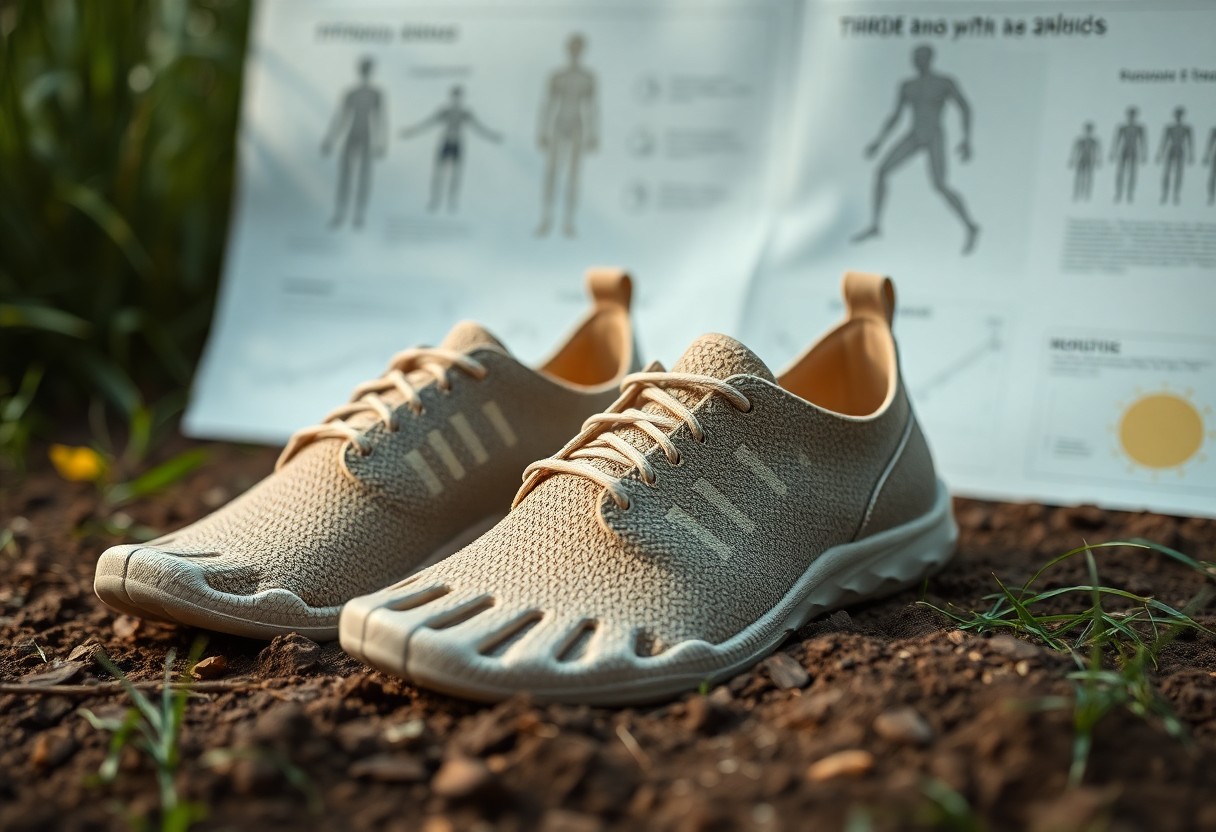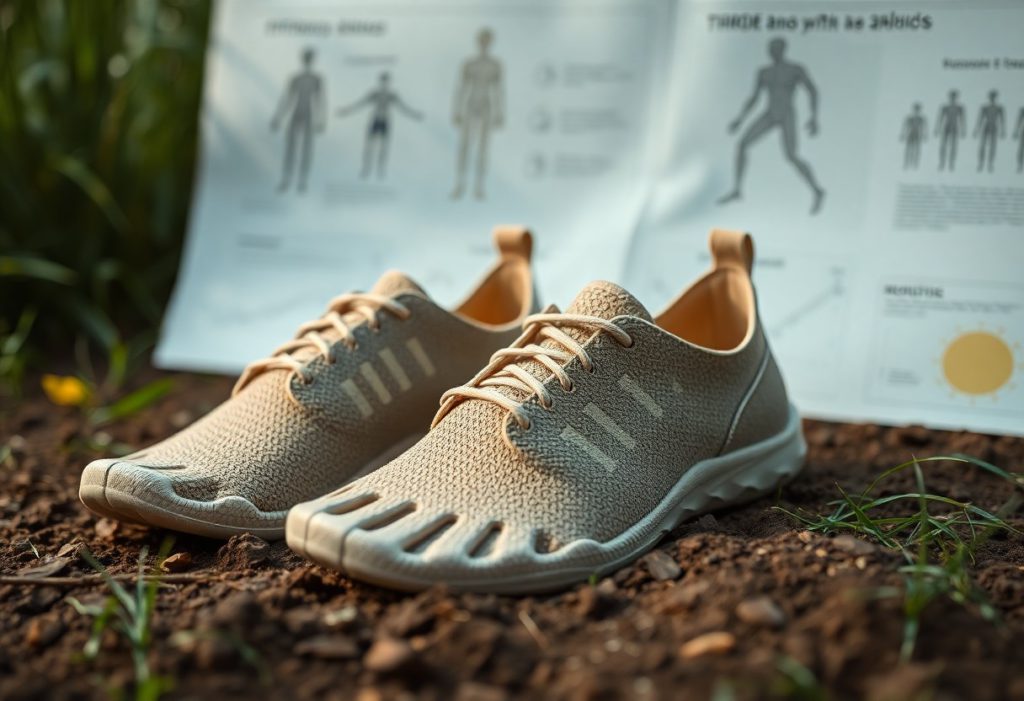Adopting sustainable design principles in footwear transcends the mere act of waste reduction; it has a profound impact on foot health as well. The innovative Barefoot shoes are leading a transformative shift within the industry, significantly decreasing CO₂ emissions through the utilisation of pioneering materials and streamlined manufacturing techniques. By choosing these eco-conscious designs, you actively participate in creating a future where biomechanical optimisation aligns with environmental accountability. Join the expanding movement towards footwear that not only enhances your physical health but also prioritises the well-being of our planet. Detailed lifecycle assessments illustrate how minimalist shoe designs can substantially lower your carbon footprint, yielding a positive influence on both personal health and environmental sustainability.
Innovating Footwear Production for a Sustainable Future
To genuinely revolutionise footwear production, it is imperative to embrace forward-thinking strategies that effectively reduce the environmental impact associated with this sector. The footwear industry plays a significant role in global CO₂ emissions, making it essential to adopt sustainable practices that not only focus on ecological balance but also protect consumer well-being. By concentrating on advanced material sourcing, enhancing manufacturing efficiency, and implementing comprehensive end-of-life management strategies, the footwear industry can make substantial strides in minimising its carbon footprint. This shift not only benefits the environment but also aligns with the rising consumer demand for responsible and sustainable products that reflect contemporary values.
Utilising Cutting-Edge Materials for Enhanced Sustainability
Progressive brands are increasingly embracing disruptive material innovations to drastically lessen their environmental impact. For instance, Xero Shoes’ dedication to incorporating materials such as hemp and recycled PET has achieved an impressive reduction in production emissions by 32%, resonating with the growing consumer preference for sustainable offerings. This strategic transition not only safeguards local ecosystems but also fosters a circular economy by actively minimising waste throughout the production process. By prioritising these eco-friendly materials, brands enhance their commitment to environmental stewardship while appealing to a conscientious and discerning consumer base.
Conducting Comprehensive Lifecycle Analyses for Carbon Footprint Reduction
Implementing thorough lifecycle analysis is vital for accurately evaluating the overall carbon footprint of footwear products. By scrutinising each phase—from material sourcing and manufacturing to usage and eventual disposal—you can identify critical areas ripe for improvement. For instance, the emissions associated with barefoot shoes typically range from 10-20 kg CO₂e per pair, reflecting an impressive 40% reduction compared to conventional athletic footwear. Initiatives such as Vivobarefoot’s ReVivo programme, which extends the lifespan of shoes and reduces emissions to just 5.8 kg CO₂e, underscore the substantial advantages that sustainability measures can yield in enhancing production efficiency and attracting conscious consumers.
Boosting Foot Health Through Biomechanics and Barefoot Design
The integration of biomechanics into the design of barefoot shoes amplifies the manifold advantages associated with minimalist footwear, leading to improvements in both foot health and sustainability. By prioritising natural foot movement, these shoes enable your feet to function as they were designed, resulting in improved posture and a decreased risk of injuries. The lightweight nature of barefoot shoes also encourages a more efficient gait, making each step more comfortable and less taxing on your body. This synergy contributes to a sense of both personal and ecological well-being, as every stride taken in these shoes aligns with a commitment to health and sustainability.
How Minimalist Designs Enhance Gait and Natural Movement
Minimalist designs found in barefoot shoes encourage a natural gait that facilitates midfoot or forefoot striking patterns. This adjustment can significantly diminish the impact forces on your joints, resulting in a more efficient and enjoyable experience while walking or running. By removing excessive cushioning and support, these shoes allow your foot muscles to engage fully, strengthening the intrinsic musculature essential for optimal movement. This natural approach to footwear not only improves your physical performance but also fosters a deeper connection with the ground, enriching your overall physical activity and enjoyment.
Scientific Insights into Energy Efficiency in Movement
Recent scientific research underscores the pivotal role of energy efficiency in the performance of barefoot shoes. Studies indicate that runners who opt for barefoot footwear experience a notable enhancement in energy return and propulsion mechanics, leading to decreased fatigue and a more sustainable running style. This directly contributes to improved movement efficiency during extended activities, making each step more productive. The thoughtful design of barefoot shoes is inherently linked to enhanced energy efficiency and better biomechanics. For example, trials involving 15 participants demonstrated that those wearing minimalist shoes made from algae-foam materials reported an energy return rate of 89%, compared to just 82% for traditional EVA foams. This dynamic nature of barefoot footwear not only allows for a more natural range of motion but also significantly alleviates knee strain during various activities. By leveraging these benefits, barefoot shoes emerge as an environmentally conscious choice as well as a revolutionary solution for achieving optimal energy efficiency in motion.

Understanding Consumer Trends in Sustainable Footwear Demand
Comprehending consumer motivations is crucial for encouraging the widespread adoption of sustainable footwear. Today's buyers increasingly prioritise ecological and health advantages, gravitating towards products that meet their functional needs while aligning with their personal values regarding environmental responsibility and overall well-being. As awareness of sustainability grows, consumers actively seek footwear brands that embody these principles and contribute positively to the planet.
Recognising Eco-Conscious Consumer Trends and Preferences
As sustainability emerges as a fundamental value, eco-conscious consumers are increasingly on the lookout for footwear brands that embody these ideals. Recent statistics indicate that 43% of shoppers are willing to pay a premium of 30% for sustainably produced shoes, highlighting a significant shift in consumer priorities towards eco-friendly materials and practices. This trend emphasises the growing importance of sustainability as a central factor influencing purchasing decisions, prompting brands to adopt more responsible production methodologies.
Evaluating the Perceived Value of Sustainability in Footwear
The perception of value surrounding sustainability in footwear is more than just a fleeting trend; it is a core aspect of purchasing decisions. As consumers, you are likely influenced by environmental considerations, health benefits, and assurances of durability, with research indicating that perceived environmental benefits rank highest among consumer motivations. By selecting sustainable footwear, you are supporting a broader movement towards responsible consumption, which resonates with a significant number of buyers today.
This rising sentiment towards environmental impact shows that consumers value brands which prioritise sustainable features. Such perceptions of value foster stronger brand loyalty and can amplify the impact of your purchasing choices, encouraging manufacturers to invest in greener practices and materials. Ultimately, sustainability enhances the perceived worth of a product, aligning your decisions with broader environmental objectives while effectively satisfying your footwear needs.
Navigating the Regulatory Landscape for Sustainable Footwear Advancements
The ever-evolving regulatory landscape plays a vital role in steering the footwear industry towards sustainable innovation. With increasing scrutiny on carbon emissions and environmental degradation, new regulations are being introduced to promote greener practices within manufacturing processes. Adhering to these emerging mandates not only addresses pressing environmental issues but also aligns with consumer expectations, compelling brands to innovate responsibly and transparently while meeting compliance standards.
Deciphering Compliance Mandates: Fueling Sustainable Practices
Emerging compliance mandates, particularly within the European Union, are establishing the foundation for sustainable practices across the footwear industry. By 2027, regulations will necessitate a minimum of 20% recycled content in footwear materials, while by 2026, carbon labelling will be obligatory for all athletic shoes. These guidelines challenge brands to reconsider their material sourcing, production processes, and end-of-life strategies, ensuring greater accountability and environmental stewardship within the sector.
Harnessing Innovation Through Regulation: Challenges and Opportunities
While new regulations present various challenges, they simultaneously open up innovative opportunities for brands willing to adapt. Embracing compliance mandates encourages companies to invest in sustainable technologies, developing solutions that reduce carbon footprints while enhancing overall product performance. Brands are exploring biodegradable materials and advanced manufacturing techniques that can lead to improved durability and diminished waste. However, navigating the complexities of regulatory compliance requires an agile approach, as organisations must balance sustainability objectives with market demands and cost considerations.
In light of these complexities, the regulatory landscape nurtures a culture of innovation that promotes the development of new materials and processes. Embracing technologies like 3D printing and biobased materials not only aligns with compliance requirements but also presents unique branding opportunities that resonate with environmentally conscious consumers. Brands that are willing to embrace these transformative changes will distinguish themselves in a competitive market, driving progress while adhering to rigorous environmental standards. By perceiving regulation as an opportunity rather than a barrier, you can position your brand at the forefront of the sustainable footwear movement.
Imagining the Future of Footwear: Where Technology Meets Sustainability
The intersection of technology and sustainability is redefining the footwear landscape as we know it. Manufacturers are leveraging advanced materials and incorporating intelligent features, promising enhanced performance while simultaneously minimising environmental impact. Innovations such as 3D printing and smart systems are paving the way for designs that not only cater to your foot health needs but also uphold ecological integrity. This dynamic transformation reflects a deepening commitment to merging functionality with environmental accountability in the footwear industry.
Incorporating Smart Features in Footwear: Elevating User Experience and Ecological Impact
Smart features in footwear greatly enhance your experience while contributing to sustainability goals. By integrating sensors, these shoes can deliver real-time feedback on your gait, allowing you to optimise performance and effectively reduce injury risks. Furthermore, these innovations often utilise eco-friendly materials, ensuring that your athletic pursuits align seamlessly with your desire to protect the environment.
On-Demand Production: Customised Solutions Through 3D Printing in Sustainable Footwear
On-demand production harnesses 3D printing technology to create shoes tailored precisely to your individual needs. This innovative method not only facilitates a custom fit but also significantly curtails waste generated by traditional manufacturing processes. By utilising advanced 3D printing techniques, brands can produce footwear that accurately reflects individual foot dimensions based on pressure mapping and biometric data. This level of personalisation minimises the chances of returns and surplus inventory, with studies indicating a 73% reduction in waste through on-demand manufacturing practices. Additionally, localised production reduces transportation emissions and bolsters regional economies. As brands adopt this technology, you gain access to footwear that is not only better suited to your feet but also more environmentally responsible.
Your Influence in the Sustainable Footwear Movement
In summary, the innovations surrounding sustainable footwear are transforming the industry by aligning biomechanics with environmental accountability in barefoot shoe design. By integrating minimalist footwear into your daily life, you can enhance your foot health while making a substantial reduction in your carbon footprint. Choosing shoes that prioritise sustainable materials and ethical manufacturing practices supports a paradigm shift towards a more eco-conscious market. Embracing these advancements not only benefits you personally but also contributes to the overarching mission of planetary health, fostering a future where functionality and sustainability coexist in harmony.
The Article Sustainable Footwear Innovation: Bridging Biomechanics and Environmental Responsibility in Barefoot Shoe Design appeared first on My Shoes Finder
The Article Sustainable Footwear Innovation in Eco-Friendly Barefoot Design Was Found On https://limitsofstrategy.com









The emphasis on sustainable design in footwear truly resonates with me, especially considering how closely linked our health and the environment are. I’ve personally transitioned to minimalist shoes over the past year and have not only felt improvements in foot health but also a greater sense of responsibility towards my carbon footprint. It’s fascinating to see how innovation in materials and production methods can redefine our daily choices, making them not just healthy but also environmentally conscientious.
Embracing sustainable footwear truly resonates with me, especially when considering the intersection of design, health, and environmental stewardship. I’ve recently transitioned to wearing minimalist shoes, and the difference has been remarkable—not just in comfort but also in how connected I feel to the ground beneath my feet. It’s interesting to ponder how our choices, like selecting Barefoot shoes, can pave the way for broader changes in consumer behavior and manufacturing practices.